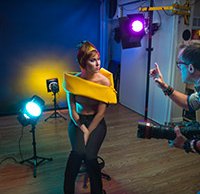Shutter Release: 3 videos about lighting techniques, dramatic black and white images and more
posted Tuesday, September 19, 2017 at 6:00 AM EST

In our regular roundup feature, Shutter Release, we share and summarize interesting photography content we see from around the web. It could be video tutorials about Photoshop, an opinion piece about a new camera or really anything that we think our readers would enjoy seeing. We are dedicated to bringing you the best original content we can, but we also want to share the great work our colleagues are doing as well.
Today's Shutter Release kicks off with a pair of lighting videos from two regularly-featured photographers on Shutter Release. We then will see how to create dramatic black and white images, how to remove anything using Photoshop's content-aware fill functionality and finish with a video on how to easily get a black background, even when shooting with a white backdrop. Hopefully the educational content we share today will help you learn something new. Let's get started.
LED continuous lights versus strobes, which is the better studio lighting solution? Joe Edelman
Photographer Joe Edelman, whose work we have shared on numerous occasions, has made a new video comparing LED continuous lighting versus strobe lighting in a studio environment. It's an interesting look at two viable options and he delivers pros and cons for each.
3 ways to sync your strobes and camera - The Slanted Lens
Photographer Jay P. Morgan is another regular here at Imaging Resource. His YouTube content is great for portrait photographers of all levels. His latest video is all about how to sync your strobes and your camera. He covers three methods in the video below.
Creating dramatic black and white photographs with Photoshop - Tutvid
Removing anything in Photoshop using content-aware fill - PiXimperfect
How to get a black background even when shooting in front of a white wall - ISO 1200
Andrew Boey of Beyond Photography shows you how to use lighting to turn a white backdrop into a black background. It has to do with light intensity, camera settings and preventing light from spilling onto your background.